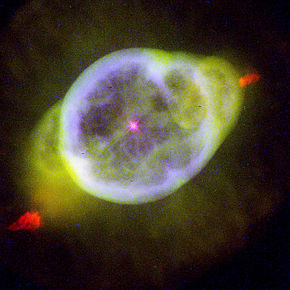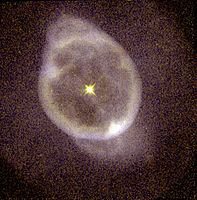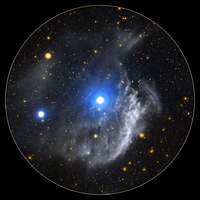NGC 3242
| NGC 3242 | |
|---|---|
 | |
| Pozorovací údaje (Ekvinokcium J2000,0) | |
| Typ | planetární mlhovina |
| Objevitel | William Herschel[1] |
| Datum objevu | 1785[1] |
| Rektascenze | 10h 24m 46,11s[2] |
| Deklinace | -18°38′32,64″[2] |
| Souhvězdí | Hydra (lat. Hya) |
| Zdánlivá magnituda (V) | 7,7[1] |
| Úhlová velikost | 45" × 36"[1] |
| Vzdálenost | 1 400[3] až 3 568[4] ly |
| Označení v katalozích | |
| New General Catalogue | NGC 3242 |
| 2MASS | 2MASS J10244612-1838321 |
| IRAS | IRAS 10223-1823 a IRAS F10223-1823 |
| Jiná označení | Ghost of Jupiter, PK261+32.1,[1] Caldwell 59 |
| (V) – měření provedena ve viditelném světle | |
| Některá data mohou pocházet z datové položky. | |
NGC 3242 (také známá jako Jupiterův duch nebo Caldwell 59) je planetární mlhovina v souhvězdí Hydry. Mlhovina má namodralý[3] až nazelenalý[5] odstín a na obloze se nachází 2 stupně jižně od hvězdy μ (42) Hydrae. Má malý rozměr, ale velkou jasnost, proto při malém zvětšení vypadá jako hvězda. Ve větším dalekohledu je možné za dobrých podmínek spatřit i slabou vnější obálku.[6] 1,5 stupně severozápadně od ní se nachází slabá galaxie NGC 3200.
Mlhovinu objevil britský astronom William Herschel 7. února 1785 a zapsal ji do katalogu jako "H IV-27". John Herschel ji v roce 1830 pozoroval z Mysu Dobré naděje v Jižní Africe, označil ji "h 3248" a v roce 1864 ji zapsal do General Catalogue jako "GC 2102". John Dreyer ji pak v roce 1888 zapsal do New General Catalogue jako NGC 3242.
Tato planetární mlhovina se často nazývá Jupiterův duch (anglicky Ghost of Jupiter), kvůli svému úhlovému rozměru podobnému s touto planetou, ale někdy bývá v angličtině nazývána i Eye Nebula. Hlavní část má rozměry 26″ × 16″ a slabší vnější obálka přibližně 40″ × 35″. Kolem mlhoviny se rozpíná mnohem větší slabé halo, které má rozměr zhruba 1250″, tedy 20,8 obloukových minut.[7] Toto halo je vidět na ultrafialovém snímku z vesmírného teleskopu GALEX. Mlhovina má skutečný rozměr zhruba 2 světelné roky a centrální hvězda s označením HD 90255 je bílý trpaslík s magnitudou 12. Vnitřní vrstvy mlhoviny vznikly před asi 1 500 lety.[8] Oba konce mlhoviny jsou označeny výběžky nadzvukovou rychlostí se šířícího málo ionizovaného plynu (Fast Low-Ionization Emission Regions, zkráceně FLIERS), které bývají v nepravých barvách zbarvovány červeně.[9]
Galerie obrázků
- Snímek z 10 palcového (254 mm) Schmidt-Cassegrainova dalekohledu.
- Snímek vnitřní části z Hubbleova vesmírného dalekohledu
- Ultrafialový snímek z vesmírného teleskopu Galaxy Evolution Explorer (NASA).
- NGC 3242 na snímku ve viditelném spektru ze Schulmanova dalekohledu o průměru 80 cm na hoře Mt. Lemmon v Arizoně.
Související články
Reference
V tomto článku byl použit překlad textu z článku NGC 3242 na anglické Wikipedii.
- ↑ a b c d e The NGC/IC Project: Results for NGC 3242 [online]. [cit. 2016-04-07]. Dostupné v archivu pořízeném dne 2009-05-28. (anglicky)
- ↑ a b SIMBAD Astronomical Database: Results for NGC 3242 [online]. [cit. 2016-04-07]. Dostupné online. (anglicky)
- ↑ a b Stephen James O'Meara. The Caldwell Objects. [s.l.]: Sky Publishing Corporation, 2002. ISBN 0-933346-97-2. S. 234–237.
- ↑ STANGHELLINI, Letizia; SHAW, Richard A.; VILLAVER, Eva. The Magellanic Cloud Calibration of the Galactic Planetary Nebula Distance Scale. S. 194–202. Astrophysical Journal [online]. 2008-12-10 [cit. 2016-04-07]. Roč. 689, čís. 1, s. 194–202. Dostupné online. arXiv 0807.1129. doi:10.1086/592395. Bibcode 2008ApJ...689..194S. (anglicky)
- ↑ Greg Crinklaw. The Ghost of Jupiter [online]. [cit. 2016-04-07]. Dostupné online. (anglicky)
- ↑ Michal Kodriš. Průvodce hvězdnou oblohou: Hydra [online]. [cit. 2016-04-07]. Dostupné online.
- ↑ FROMMERT, Hartmut. NGC 3242 [online]. SEDS [cit. 2016-04-07]. Dostupné online. (anglicky)
- ↑ MOBBERLEY, Martin. The Caldwell Objects and How to Observe Them. [s.l.]: Springer Science+Business Media, LLC, 2009. Dostupné online. S. 128. (anglicky)
- ↑ NGC 3242, Ghost of Jupiter [online]. ESA [cit. 2016-04-07]. Dostupné online. (anglicky)
Externí odkazy
 Obrázky, zvuky či videa k tématu NGC 3242 na Wikimedia Commons
Obrázky, zvuky či videa k tématu NGC 3242 na Wikimedia Commons - Simbad – NGC 3242
Média použitá na této stránce
A en:Hubble Space Telescope (HST) image of en:NGC 3242. Credit: HST/en:NASA/en:ESA. http://www.spacetelescope.org/images/html/opo9738c13.html
This ultraviolet image from NASA's Galaxy Evolution Explorer shows NGC 3242, a planetary nebula frequently referred to as "Jupiter's Ghost."
The unfortunate name of "planetary nebula" for this class of celestial object is a historical legacy credited to William Herschel during the 18th century -- a time when telescopes where small and objects like these, at least the central region, looked very similar to gas-giant planets such as Saturn and Jupiter. In fact, NGC 3242 has no relation to Jupiter or any other planet.
Telescopes and their detectors have dramatically improved over the past few centuries. Our understanding of what planetary nebulae truly are has improved accordingly.
When stars with a mass similar to our sun approach the end of their lives by exhausting supplies of hydrogen and helium fuel in their cores, they swell up into cool red-giant stars. In a last gasp before death, they expel the layers of gas in their outer atmosphere. This exposes the core of the dying star, a dense hot ball of carbon and oxygen called a white dwarf. The white dwarf is so hot that it shines very brightly in the ultraviolet. The ultraviolet light from the white dwarf, in turn, ionizes the gaseous material expelled by the star causing it to glow. A planetary nebula is really the death of a low-mass star.
Although low-mass stars like our sun live for billions of years, planetary nebulae only last for about ten thousand years. As the central white dwarf quickly cools and the ultraviolet light dwindles, the surrounding gas also cools and fades.
In this image of NGC 3242 from the Galaxy Evolution Explorer, the extended region around the planetary nebula is shown in dramatic detail. The small circular white and blue area at the center of the image is the well-known portion of the famous planetary nebula. The precise origin and composition of the extended wispy white features is not known for certain. It is most likely material ejected during the star's red-giant phase before the white dwarf was exposed. However, it may be possible that the extended material is simply interstellar gas that, by coincidence, is located close enough to the white dwarf to be energized by it, and induced to glow with ultraviolet light.
NGC 3242 is located 1,400 to 2,500 light-years away in the constellation Hydra. It was discovered by William Herschel in 1785.Der recht helle Planetarische Nebel NGC 3242 ist nicht nur visuell ein dankbares Objekt. Auch fotografisch ist er bereits mit einer unmodifizierten Webcam erfaßbar. Die Aufnahme entstand in Bad Tölz am 15.1.2007 um 3:08 MEZ. Aufgenommen wurde mit der ToUcam 840 an einem 10" SCT. Die Brennweite wurde mittels Reducer auf 1.436mm verkürzt.
Autor: Jschulman555, Licence: CC BY-SA 3.0
NGC 3242 using 32 inch Schulman telescope on Mt. Lemmon, AZ








